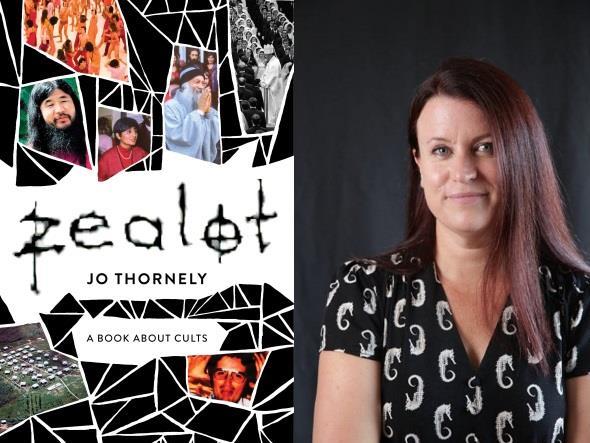Cover and author image supplied by Hachette.
In 1985, Jo Thornely needed to choose a subject for a talk. She decided on cults because she figured ‘almost everyone is at least a little bit fascinated’ by them. She has been obsessed with them ever since, and her popular podcast on the subject — also titled Zealot — has captivated listeners since 2017. In the book Zealot, Thornely details the history and practices of ten cults, with particular emphasis on their leaders.
Zealot makes for frightening reading.
Thornely has adopted the same tone that she uses in her podcasts — a style best described in her own words as communicating ‘about bad stuff in a fun way’. Thornely manages to do this without trivialising what is an important and serious subject – not a mean feat. For example, when describing one of the distributors of sarin gas in the Tokyo underground, Thornely writes that they were ‘also carrying an umbrella which had had its tip filed to a sharp point, like an unexpectedly sinister Mary Poppins’. Thornely adds that as well as the human casualties, ‘some of the trains in Japan were late, which hardly ever happens. A spoonful of sarin helps the Tokyo railway system go down.’
To understand what is meant by a cult, Thornely argues that it must fulfil most, or all, of a certain set of criteria. In brief, she contends that a cult has a leader who must be followed, prescribes a specific way of life, and has definite separation in some form from the outside world. Further, there are serious consequences for those who leave the cult, and it has its own set of unique beliefs.
Unfortunately there is no single word in the English language that describes something even worse than evil. In this book, though, nine of the ten cults described need that missing word to indicate the degree of depravity of their founders or leaders. Not all cult members, however, deserve the same opprobrium. According to Thornely, people are often drawn to a cult because their ‘current religion or lifestyle is lacking – it’s too restrictive, it’s not restrictive or pious enough, it doesn’t seem to offer solutions for a chaotic and dangerous world, it doesn’t let them have enough sex with aliens’ — or enough sex generally.
The first cult described in Zealot is the Peoples Temple founded by Jim Jones in the 1950s. The mass murder-suicide of more than 900 of its members in 1978 was the most deadly single incident against US civilians before 9/11. In another cult known as Branch Davidians, 76 members ended their lives in flames. After the fire died down, investigators found ‘hundreds of firearms . . . and forty-eight guns that had been illegally modified to convert them into fully automatic weapons’. This was a cult that started as an offshoot of the Seventh Day Adventists and lost its way under a variety of leaders.
In many ways, this book is a warning not to join a cult. In a short chapter at the end of the book Thornely gives advice on how to tell if you are a member of a cult. How you could unknowingly be in such a position may seem puzzling, but after reading this book, it is not as surprising as it might seem. As revealed in Zealot, the propensity of people to believe the unbelievable is staggering.
It is not pleasant to read about very evil people and their dupes or victims. But for those who wish to understand the world as it is, it is sometimes an unavoidable task. In that sense, Thornely is doing the community a great service by providing insights into some of the cults that have destroyed the lives of many.
4 stars ★★★★





